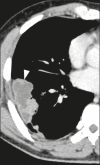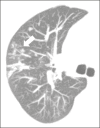Tomographic assessment of thoracic fungal diseases: a pattern and signs approach
- PMID: 30369659
- PMCID: PMC6198837
- DOI: 10.1590/0100-3984.2017.0223
Tomographic assessment of thoracic fungal diseases: a pattern and signs approach
Abstract
Pulmonary fungal infections, which can be opportunistic or endemic, lead to considerable morbidity and mortality. Such infections have multiple clinical presentations and imaging patterns, overlapping with those of various other diseases, complicating the diagnostic approach. Given the immensity of Brazil, knowledge of the epidemiological context of pulmonary fungal infections in the various regions of the country is paramount when considering their differential diagnoses. In addition, defining the patient immunological status will facilitate the identification of opportunistic infections, such as those occurring in patients with AIDS or febrile neutropenia. Histoplasmosis, coccidioidomycosis, and paracoccidioidomycosis usually affect immunocompetent patients, whereas aspergillosis, candidiasis, cryptococcosis, and pneumocystosis tend to affect those who are immunocompromised. Ground-glass opacities, nodules, consolidations, a miliary pattern, cavitary lesions, the halo sign/reversed halo sign, and bronchiectasis are typical imaging patterns in the lungs and will be described individually, as will less common lesions such as pleural effusion, mediastinal lesions, pleural effusion, and chest wall involvement. Interpreting such tomographic patterns/signs on computed tomography scans together with the patient immunological status and epidemiological context can facilitate the differential diagnosis by narrowing the options.
Pneumopatias fúngicas proporcionam considerável morbidade e mortalidade, podendo ser oportunistas ou endêmicas. De maneira geral, as apresentações clínicas e padrões de imagem são múltiplos e superponíveis a várias doenças, dificultando a abordagem diagnóstica. Tendo em conta a amplitude do território nacional, o conhecimento da realidade epidemiológica dessas doenças em cada região é fundamental para a consideração delas no diagnóstico diferencial. A definição do estado imunológico irá, ainda, definir a possibilidade de doenças fúngicas oportunistas, por exemplo, na síndrome da imunodeficiência adquirida ou em situações de neutropenia febril. Em geral, histoplasmose, coccidioidomicose e paracoccidioidomicose comprometem indivíduos imunocompetentes, e aspergilose, candidíase, criptococose e pneumocistose comprometem indivíduos imunodeprimidos. Vidro fosco, nódulos, consolidações, micronódulos de disseminação miliar, lesões escavadas, sinal do halo/halo invertido e bronquiectasias são padrões tomográficos frequentes no acometimento pulmonar e serão abordados individualmente, além de apresentações menos frequentes, como lesões mediastinais, derrame pleural e acometimento da parede torácica. A interpretação desses padrões/sinais tomográficos básicos associados a dados epidemiológicos e estado imunológico do paciente pode ser útil, contribuindo para o estreitamento das opções diagnósticas.
Keywords: Diagnostic imaging; Invasive fungal infections; Tomography, X-ray computed.
Figures












References
-
- Xavier MO, Oliveira FM, Severo LC. Capítulo 1 - Diagnóstico laboratorial das micoses pulmonares. J Bras Pneumol. 2009;35:907–919. - PubMed
-
- McAdams HP, Rosado-de-Christenson ML, Lesar M, et al. Thoracic mycoses from endemic fungi: radiologic-pathologic correlation. Radiographics. 1995;15:255–270. - PubMed
-
- McAdams HP, Rosado-de-Christenson ML, Templeton PA, et al. Thoracic mycoses from opportunistic fungi: radiologic-pathologic correlation. Radiographics. 1995;15:271–286. - PubMed
-
- Chong S, Lee KS, Yi CA, et al. Pulmonary fungal infection: imaging findings in immunocompetent and immunocompromised patients. Eur J Radiol. 2006;59:371–383. - PubMed
-
- Brasil. Ministério da Saúde. Secretaria de Vigilância em Saúde Proposta de vigilância epidemiológica da paracoccidioidomicose. [2017 Aug 18]. Available from: http://www.sgc.goias.gov.br/upload/arquivos/2012-05/proposta_ve-pbmicose....
Publication types
LinkOut - more resources
Full Text Sources
